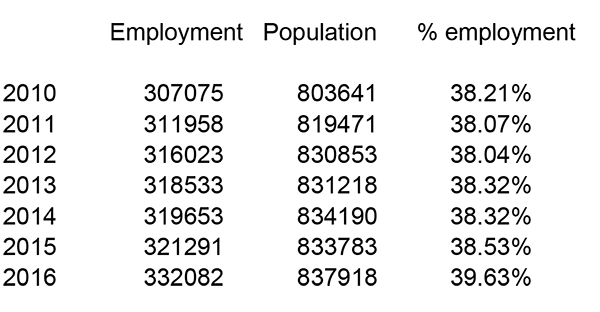I’ve been sussing out the employment situation here in El Paso over the last some years, and here’s what I’ve come up with.
From 2010 to 2016, employment as a percentage of population has been pretty constant.
We’ve been running a pretty steady 38% to 38.5% since 2010. Except for last year. Last year, employment as a percentage of population jumped to 39.63%
Look at these charts from the Bureau of Labor Statistics:
The Labor Force, i.e., the number of people participating in the labor market, i.e., working, or looking for work, takes a pretty decided jump there about July, 2015, after an anomalous bump in about April. What happened?
I’m gonna say Go 10.
GO 10 is an infrastructure reconstruction of Interstate 10 on El Paso’s Westside, between the Executive Center Boulevard and North Mesa Street exits. At $158 million, GO 10 is the largest traditionally delivered (design-bid-build) project that TxDOT’s El Paso District has done to date. Construction started in April 2015, and is expected to be complete in 2019.
In April, 2015, TxDOT started injecting $158 million into the local economy in regular measured doses, one pay period at a time.
As I’ve said before,
What do you think has more effect on the El Paso economy. A downtown arena, or the value of the peso? An indoor driving range, or the price of labor in China? A convention center hotel, or the military budget?
City Council thinks that they’re gods, but they’re not. City Council trying to control the El Paso economy is like eight fleas trying to drive an elephant.
City government needs to stop patting themselves on the back and start looking ahead to 2019 and 2020, when Go 10 and the new William Beaumont Hospital are completed. Of course, maybe by that time, the federal government will be building a wall to replace the fence.
Note: Population estimates are from the U.S. Census Bureau for July 1, of each year. Work force numbers are not seasonally adjusted and are from the Bureau of Labor Statistics for July of each year.




Your Go-10 theory fits into a larger theory of mine, government spending is El Paso’s main business, which is worrisome. The highway project you reference, more Border Patrol/DEA/customs agents, Ft. Bliss in general, still some ongoing construction at Fort Bliss, perhaps a border wall construction project to boot. Then at the local level think about all the employees of the ISDs, the city, the county, UMC, the outlying small towns, the list of the so-called public sector goes on. And still, there’s more: all the architects, engineers, surveyors, lawyers, and other vendors that work on or supply all these projects. The question is how long can a government subsidized economy, if that is what we have, last? I am reading your blog to find out. I’ve never seen an analysis of how much of El Paso’s economy is nothing more than the injection of taxpayer funds, which are then recycled (multiplier effect) as everyone spends money at the stores, restaurants, doctor’s office, etc.
Go 10, Fort Bliss, and border security are different than the school districts and municipal government spending. Expenditures from local taxes aren’t more money in the local economy. State and federal money are. When the local governments spend local tax money, that’s just redistributing what we already have.